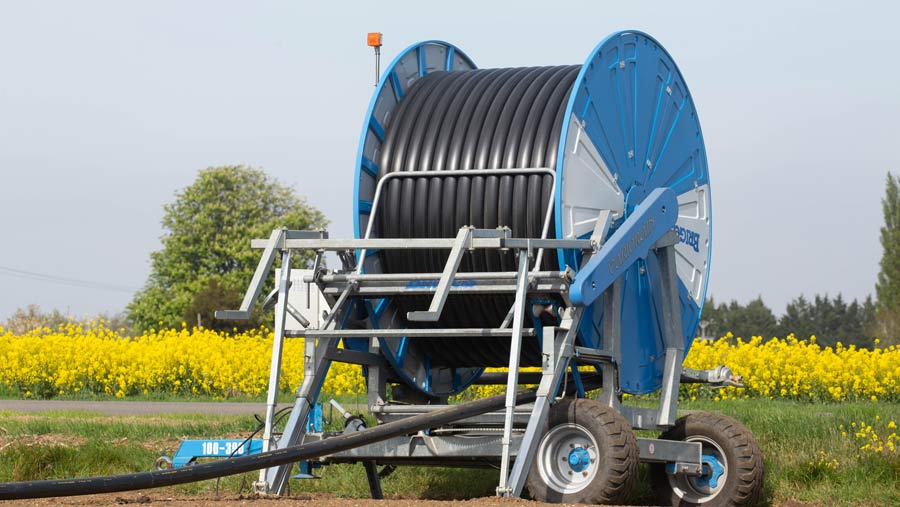Dry April heightens drought fears for farmers
 © Tim Scrivener
© Tim Scrivener A dry April has raised concerns the UK could be headed for a drought and left farmers desperate for rain to soak parched crops and grassland.
April has been notably dry, with only around half the normal amount of rainfall in England and Wales.
The outlook is for the month to finish with a mostly dry week, but any chances of significant rainfall do not look likely for some time.
See also: So you want to… build a reservoir?
Farmers across the UK need a spell of wet weather to help wash in fertiliser that has been applied in recent weeks at great cost, owing to soaring input prices.
“The weather is just so contrary these days,” said Guy Smith, who farms 350ha in St Osyth, Essex, the driest part of the UK on average.
“In this patch of Essex, having struggled with too much rain in the autumn and not getting crops established, we seem to be straight into the spring drought.
“Spring drilling was done in reasonably good conditions. Some crops are up nicely, but others on less than decent seedbeds are now really struggling.”
Fertiliser ‘sat on top of ground’
Having just applied expensive fertiliser, and then to see it sitting on the top of the ground and not doing anything due to a lack of rainfall was “all a bit frustrating”, said Mr Smith.
He continued: “As the old saying goes, ‘a wind from the East is no good for man nor beast’ – and that’s exactly what we have got. We need south-westerly breezes.”
But Mr Smith remains hopeful that showers in May will come to rescue the situation and avert a crisis.
“I’m not getting too down in the mouth yet,” he said. I’m hopeful the weather will come right for farmers.”
In Norfolk, arable farmer Kit Papworth posted a photo on his Twitter page of him irrigating cereal crops. He said: “Sign of the times. Irrigating cereals in April.”
Sign of the times.
Irrigating cereals in April. #drought
@Cereals_EA @bencm305 @foreverwaiting6 @dgwhoyles @johnhaynes84 pic.twitter.com/qqbmpoV4D4— Kit Papworth (@farmerkit) April 26, 2022
Rob Gardner, farm manager at Manor Farm in Upton Grey, near Basingstoke, Hampshire said spring crops, including peas, beans and wheat had emerged well, but now needed rain.
“It’s becoming a worry. If we get rain in the next week, we’ll all be very happy,” he said. “If it stays dry over the next two to three weeks, it will start to have more of an impact on the spring crops than the winter crops.”
‘Not critical yet’
Dairy farmer David Christensen manages 950 milking cows across two units in Oxfordshire, where he farms around 600ha, including 132ha of maize.
Mr Christensen said he was feeling “cautiously nervous” about the lack of rainfall. “It’s been a dry winter, followed by a dry spring and it’s very dry around the farm,” he said.
“If we get an inch or so of rain in the next fortnight, the situation could change markedly. But there’s no sign of that.
“It’s not critical yet, but it will soon be unless we get some rain over the next two to three weeks.”
Mr Christensen is not too concerned about his silage, as he expects to take his first cut in mid-May of grass grown on heavy land. However, he has established a lot of maize in the past week, which “now needs a drink”.
Dry May forecast
According to the Met Office, most of the UK has had lower than average rainfall this month, although northern Scotland has been wetter than average.
Its long-range forecast predicts that start of May will be dry, with cold nights and frosty mornings possible in rural areas. “A few showers are likely at times particularly for the North and East, where they could be heavy,” it says.
Dry, settled weather is forecast for much of the UK from mid- to end of May, with a chance of showers in places, but a lower risk of prolonged rain.
Water resource levels ‘within normal ranges’, says agency
The majority of water resource levels across England are currently within normal ranges, although groundwater recharge has been lower than normal across parts of southern England due to drier-than-average weather, the Environment Agency (EA) says.
For England, cumulative rainfall over the past three months has been drier than average. Some rivers, predominantly in the South West, have responded to the drier weather since mid-March and are currently below normal flows.
There is a low risk of drought management actions this summer with average rainfall. However, if dry weather continues through spring and into summer, the risk of drought impacts will increase.
“We are closely monitoring water levels, and continue to work with water companies and other abstractors,” said an agency spokesman.
- The EA has produced guidance for farmers abstracting during prolonged dry weather and drought, which includes abstracting water more efficiently and harvesting rainwater.
